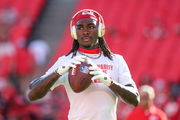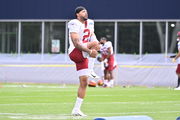
Imago
Sep 9, 2025; Las Vegas, Nevada, USA; Las Vegas Aces head coach Becky Hammon calls out a play against the Chicago Sky during the third quarter at T-Mobile Arena. Mandatory Credit: Stephen R. Sylvanie-Imagn Images

Imago
Sep 9, 2025; Las Vegas, Nevada, USA; Las Vegas Aces head coach Becky Hammon calls out a play against the Chicago Sky during the third quarter at T-Mobile Arena. Mandatory Credit: Stephen R. Sylvanie-Imagn Images
Becky Hammon was forced to ignite a conversation that had died down for a while: WNBA and its ‘excessive physicality’. After a tumultuous 41-foul Game 2 against the Indiana Fever, the Aces coach went off on the roughness in the postseason. “The physicality is out of control, that’s for sure,” Hammon said and went on to directly compare WNBA stars to its big brother, the NBA. “Most of my assistants come from the NBA, and they’re like, ‘this would not fly in the NBA.’”
Watch What’s Trending Now!
Both the Aces and Fever came out of that game bruised and battered, but the ‘physicality’ argument is more nuanced than what it is made out to be. Alicia Jay of CBS pointed it out on the “We Need To Talk” podcast. “To coach Becky’s point, she’s not wrong, but I just think that in order to grow the game and in order to excite new fans from watching it or to bring new fans in and they’re excited to watch it, especially as this league continues to grow with all the expansion teams, I do think that there should be a celebration of physicality, especially in the postseason.”
The gritty style has always been the core of the WNBA. Just look back at the early seasons of the game in the 90s and 2000s, the likes of Tina Thompson, Sheryl Swoopes, Lisa Leslie, and a host of others played with unbelievable grit and competitiveness. The thing is, the NBA was the same at the time. Now that it has changed, the drastic contrast has people calling for the WNBA to follow the NBA blueprint. But this style is what makes the W different.
ADVERTISEMENT
“Physicality has always been a WNBA thing,” says Jordan Robinson, who hosts The Women’s Hoop Show alongside Sheryl Swoopes. “It’s a sports thing! It’s been a women’s basketball thing since the beginning.” However, it does need a change in another department to make it sustainable and enjoyable, like Jay says.
She further said, “I just think that in order to do that, the officiating needs to be more even keeled. Um, but I don’t think that we should be anti-physical. I think honestly that’s what makes playoff basketball different than regular season basketball. And I think that’s what makes the sport exciting to watch.”

Imago
Jordan Teller – The Sporting Tribune
Now we get into the crux of the problem. Even A’ja Wilson echoed what Jay is trying to explain: “It’s always very physical, and it’s playoffs, so they let you get away with a lot of different things.” Rules are there to safeguard players, and the problem right now is that the rules are inconsistently implemented.
ADVERTISEMENT
You have the rule book that allows a certain level of muscle, but the referees are allowing things well beyond that. Just look at A’ja Wilson’s hard contact on Lexie Hull in the final seconds of Game 1, second quarter. The referee is looking directly at Hull when she complained, but no foul was called. In Game 2, Hull was again at the end of such hits. “I feel like I’ve been on the ground a little bit more this series so far. But we just keep getting back up.” She said after the game.
ADVERTISEMENT
In conclusion, instead of doing a complete 180 on the physicality, the WNBA should try and figure out a way to keep its flavour while protecting the players and improving the referees. It’s a tight rope to walk on, but as the league reaches more people, the responsibility increases to keep the on-court product top-notch. To do that, Cathy Engelbert will also keep the stylistic evolution in mind.
WNBA’s 3-Point Boom Could Push It Toward NBA-Style Hoops
You hear 3 point and immediately think about Caitlin Clark. The Iowa alum has practically redefined the game ever since stepping into the WNBA. Her range knows no bounds. Clark has been thrown around in the league ever since her rookie season, which has culminated in her injury-ridden 2025 season. Many have questioned whether she was the victim of the league’s physicality.
ADVERTISEMENT
And one thing Becky Hammon stressed is the importance of freedom of movement, something the NBA has emphasised on since the early 2000s, and thus its outside shooting evolution led by Steph Curry. Now, the WNBA is experiencing something similar. Just look at the per-game stats in the last four years.
| 3PM | 3PA | 2 PM | 2PA | |
| 2022 | 7.7 | 22.4
| 22.3 | 45.6 |
| 2023 | 7.7 | 22.1 | 22.5 | 46.2 |
| 2024 | 7.7 | 22.8 | 45.4 | 45.4 |
| 2025 | 8.2 | 24.2 | 43.1 | 43.1 |
Top Stories
NFL Announces Decision on Rashee Rice Incident Amid Disturbing Allegations From Ex-GF

NFL Coach of 62 Years Retires Before Todd Bowles & Buccaneers Turn Coaching Room Upside Down With 5 Firings

Brad Keselowski Snuffs Out Retirement Rumors Despite Prolonged Winless Streak

NASCAR Rumor: Fans Left Baffled as Insider Leaks ‘New Championship Format’ Weeks Before 2026 Season

Two Years After Sydney McLaughlin-Levrone, Quincy Wilson and Co. Make History With New Balance Announcement

Commanders Release Statement on Marshon Lattimore as CB Faces Charges After Arrest

Till 2024, the 3 points attempted remained relatively stable. 2024 was a slight uptick, but 2025 was a significant change. The teams are preferring 3-point shots as 2-pointers have notably reduced. Atlanta Dream and Karl Smesko have embraced the three-ball as their identity, draining 421 three-pointers (third most in the league) while 34.1% of their points came from it.
ADVERTISEMENT
The only team more dependent was Golden State Valkyries, who had 37.5% of their points from threes. Natalie Nakase did not have the firepower on the offense, and they finished as one of the worst offenses in the league, but the three-ball made what they had enough for a postseason berth. So this change is not based on Caitlin Clark or any specific player; it’s a systematic change that the fans are loving. Becky Hammon’s team has been among the top 3p makers, which makes her complaint make sense. If the trend continues, the WNBA might have to select enforcement emphases to make the basketball more fluid. It is a complicated problem, but a solution is needed to improve the game.
ADVERTISEMENT
ADVERTISEMENT
ADVERTISEMENT

